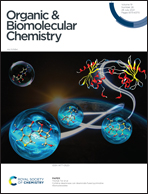Steric effects on the intramolecular charge transfer fluorescence of benzo[b]thiophene-1,1-dioxide bridged macrocages†
Abstract
Intramolecular charge transfer (ICT) fluorescence has been widely investigated and exploited in sensor molecules. However, steric effects on the ICT fluorescence properties have rarely been reported so far, although research in this area would promote an understanding of the basics of solvation. Herein, we report the detailed fluorescence properties of bis(trimethylsilyl)benzo[b]thiophene-1,1-dioxide (TMSBTO2) and its caged cyclophanes and non-cage isomers, which demonstrate ICT fluorescence in various solutions. The fluorescence band maxima for these benzo[b]thiophene-1,1-dioxides (BTO2s) showed a red-shift with increasing solvent polarity, confirming ICT fluorescence characteristics. The linearity of the Lippert–Mataga plots was confirmed for all ICT fluorescence measured in hexane, toluene, AcOEt, CH2Cl2, and EtOH. The slopes of the plots decreased in the following order: TMSBTO2, non-cage isomers, and caged BTO2s. It is concluded that the Onsager radii for these BTO2s were increased in the abovementioned order, assuming that the difference in the dipole moments between the excited and ground states for these BTO2s was identical.
![Graphical abstract: Steric effects on the intramolecular charge transfer fluorescence of benzo[b]thiophene-1,1-dioxide bridged macrocages](/en/Image/Get?imageInfo.ImageType=GA&imageInfo.ImageIdentifier.ManuscriptID=D1OB01050F&imageInfo.ImageIdentifier.Year=2021)
- This article is part of the themed collection: Supramolecular chemistry in OBC


 Please wait while we load your content...
Please wait while we load your content...